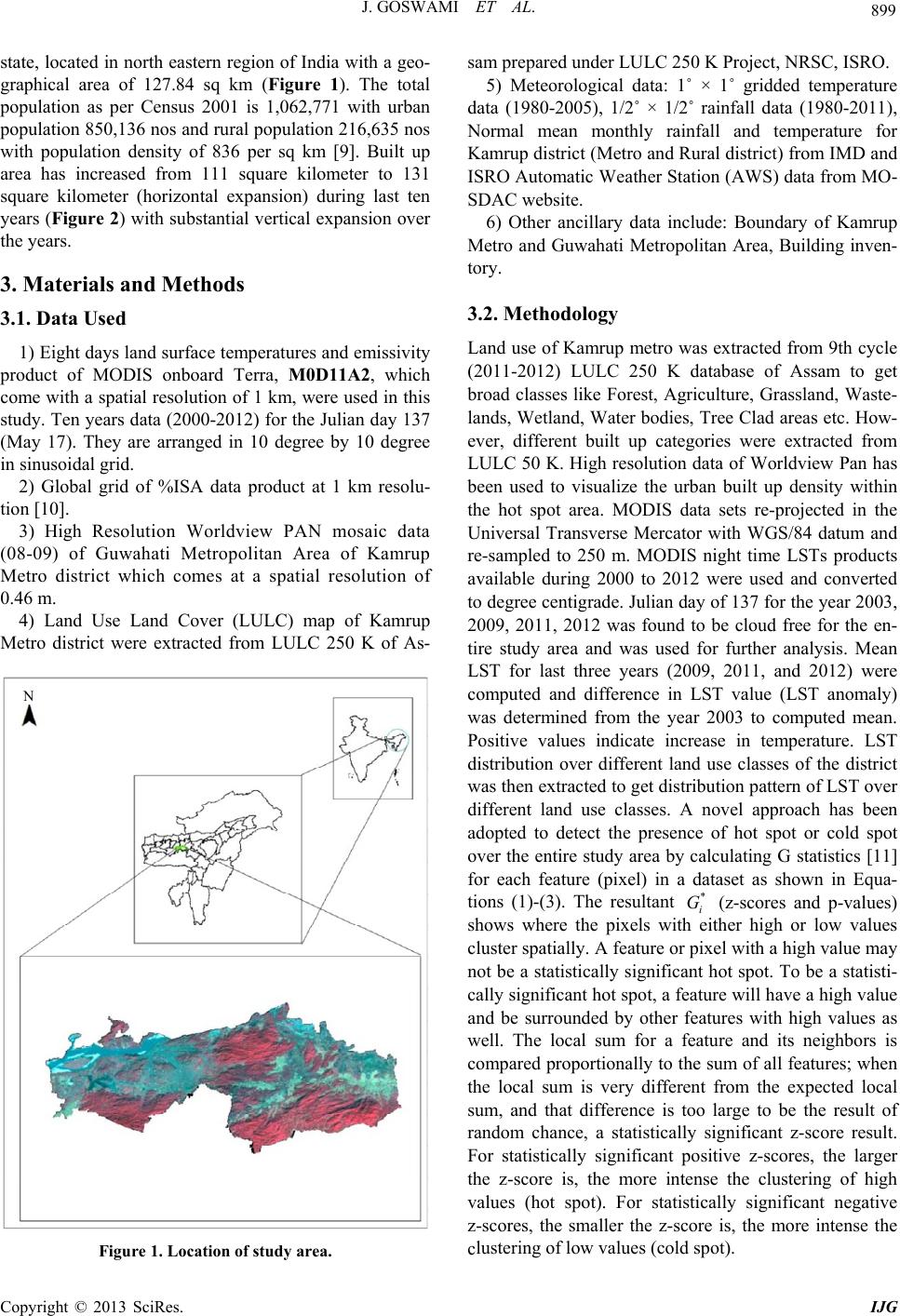
J. GOSWAMI ET AL. 899
state, located in north eastern region of India with a geo-
graphical area of 127.84 sq km (Figure 1). The total
population as per Census 2001 is 1,062,771 with urban
population 850,136 nos and rural population 216,635 nos
with population density of 836 per sq km [9]. Built up
area has increased from 111 square kilometer to 131
square kilometer (horizontal expansion) during last ten
years (Figure 2) with substantial vertical expansion over
the years.
3. Materials and Methods
3.1. Data Used
1) Eight days land surface temperatures and emissivity
product of MODIS onboard Terra, M0D11A2, which
come with a spatial resolution of 1 km, were used in this
study. Ten years data (2000-2012) for the Julian day 137
(May 17). They are arranged in 10 degree by 10 degree
in sinusoidal grid.
2) Global grid of %ISA data product at 1 km resolu-
tion [10].
3) High Resolution Worldview PAN mosaic data
(08-09) of Guwahati Metropolitan Area of Kamrup
Metro district which comes at a spatial resolution of
0.46 m.
4) Land Use Land Cover (LULC) map of Kamrup
Metro district were extracted from LULC 250 K of As-
N
Figure 1. Location of study area.
sam prepared under LULC 250 K Project, NRSC, ISRO.
5) Meteorological data: 1˚ × 1˚ gridded temperature
data (1980-2005), 1/2˚ × 1/2˚ rainfall data (1980-2011),
Normal mean monthly rainfall and temperature for
Kamrup district (Metro and Rural district) from IMD and
ISRO Automatic Weather Station (AWS) data from MO-
SDAC website.
6) Other ancillary data include: Boundary of Kamrup
Metro and Guwahati Metropolitan Area, Building inven-
tory.
3.2. Methodology
Land use of Kamrup metro was extracted from 9th cycle
(2011-2012) LULC 250 K database of Assam to get
broad classes like Forest, Agriculture, Grassland, Waste-
lands, Wetland, Water bodies, Tree Clad areas etc. How-
ever, different built up categories were extracted from
LULC 50 K. High resolution data of Worldview Pan has
been used to visualize the urban built up density within
the hot spot area. MODIS data sets re-projected in the
Universal Transverse Mercator with WGS/84 datum and
re-sampled to 250 m. MODIS night time LSTs products
available during 2000 to 2012 were used and converted
to degree centigrade. Julian day of 137 for the year 2003,
2009, 2011, 2012 was found to be cloud free for the en-
tire study area and was used for further analysis. Mean
LST for last three years (2009, 2011, and 2012) were
computed and difference in LST value (LST anomaly)
was determined from the year 2003 to computed mean.
Positive values indicate increase in temperature. LST
distribution over different land use classes of the district
was then extracted to get distribution pattern of LST over
different land use classes. A novel approach has been
adopted to detect the presence of hot spot or cold spot
over the entire study area by calculating G statistics [11]
for each feature (pixel) in a dataset as shown in Equa-
tions (1)-(3). The resultant i (z-scores and p-values)
shows where the pixels with either high or low values
cluster spatially. A feature or pixel with a high value may
not be a statistically significant hot spot. To be a statisti-
cally significant hot spot, a feature will have a high value
and be surrounded by other features with high values as
well. The local sum for a feature and its neighbors is
compared proportionally to the sum of all features; when
the local sum is very different from the expected local
sum, and that difference is too large to be the result of
random chance, a statistically significant z-score result.
For statistically significant positive z-scores, the larger
the z-score is, the more intense the clustering of high
values (hot spot). For statistically significant negative
z-scores, the smaller the z-score is, the more intense the
lustering of low values (cold spot).
*
G
c
Copyright © 2013 SciRes. IJG